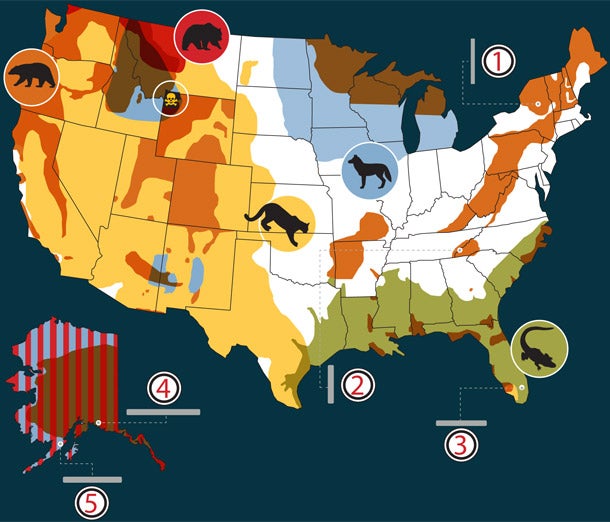Survive an Animal Attack

Least Dangerous: Wolves
Weight 60-115 lbs.
Bite force 1,500 lbs.
Fang length 2.5 inches
Unprovoked attacks are on the rise, and both fatal North American encounters occurred after 2005. Wolves stalk in packs–they don’t ambush. You may be outnumbered, but it’s likely you’ll see (and can fight off) attackers.
Tip: Make noise when traveling in predator territory. Wolves typically retreat rather than attack in defense. The only fatal U.S. wolf attack occurred after a lone jogger in Alaska surprised a pack at close range.
Alligators
Weight 700-1,000 lbs.
Bite force 2,900 lbs.
Strike range 5 to 10 feet
Kids, people crouched near shore, and swimmers are at greatest risk. Gators can stay submerged for up to two hours and may swim within shoreline striking distance undetected (under murky water or through grasses).
Tip: Stay on high alert near murky waters in spring, when gators roam new territory in search of mates. Three of the 22 gator-caused fatalities in Florida occurred in one week in May 2006.
Cougars
Weight 75-165 lbs.
Bite force 750 lbs.
Bounding distance 30 feet
These opportunistic cats have 46 recorded kills and are adept at detecting vulnerability. Keep kids close, avoid hiking solo in cougar hot spots, and don’t run if you bump into one, especially in terrain where you may trip.
Tip: Overcrowded habitat is pushing cougars east; there are confirmed sightings every year in New England. But there’s never been an attack in the Northeast, and no breeding populations exist there (yet).
Black bears
Weight 125-500 lbs.
Bite force 700 lbs.
Running speed >30 mph
Attacks are up: Of fatal encounters since 1900, 80 percent happened in the last 50 years. Lone males on the hunt are the biggest offenders; if a black bear follows you, hike toward safety. If it attacks, fight back.
Tip: Garbage and food are factors in 40 percent of black bear attacks. Keep a clean camp; there are as many as two bruins per square mile in the Smokies.
Most Dangerous: Grizzly bears
Weight 300-1,500 lbs.
Bite force 1,200 lbs.
Claw length >3 inches
Up to seventy percent of fatal attacks are by mothers defending cubs, which start exploring in March and early April. Never get between a sow and her litter, and if you see small bears, retreat quietly and immediately.
Tip: Alaska’s coastal bears bulk up to 1,500 lbs. because of fish-heavy diets. Anglers: If you hook a fish and see a bear, cut the line to avoid attracting its attention.
Predator Epicenter: Yellowstone
Home to more than 600 grizzlies, 500-plus black bears, 20 cougars, and 100 wolves, Yellowstone is in one of the country’s most predator-dense regions. Two fatal maulings last summer were the park’s first grizzly-caused deaths in 25 years, and park officials say neither victim followed standard safety protocol. One was hiking alone, and the other ran when confronted. Get bear smarts at backpacker.com/bearsafe.
Survive an Encounter
Avoid Make noise in low-visibility areas and hike in groups. Stay away from carcasses, and keep camp food-scrap-free. Hiking in gator country? Stay 10 to 15 feet from shore.
Evade The only predator on this list you might outrun is the alligator. If you encounter a bear, mountain lion, or wolf, don’t run. Back away slowly and prep your bear spray. You can use it to deter an attack from any predator.
Survive Only play dead if a grizzly’s attacking. For any other predator, fight back–hit the eyes and face–like your life depends on it. It does.